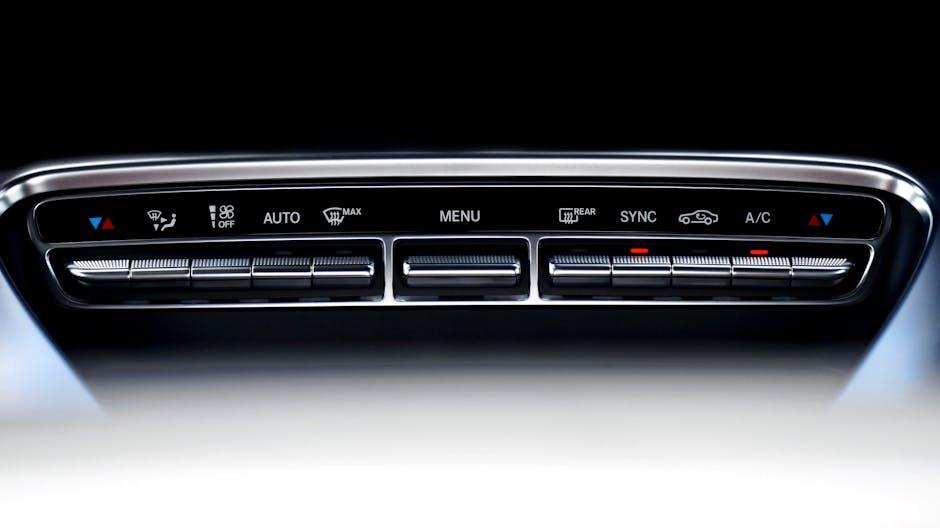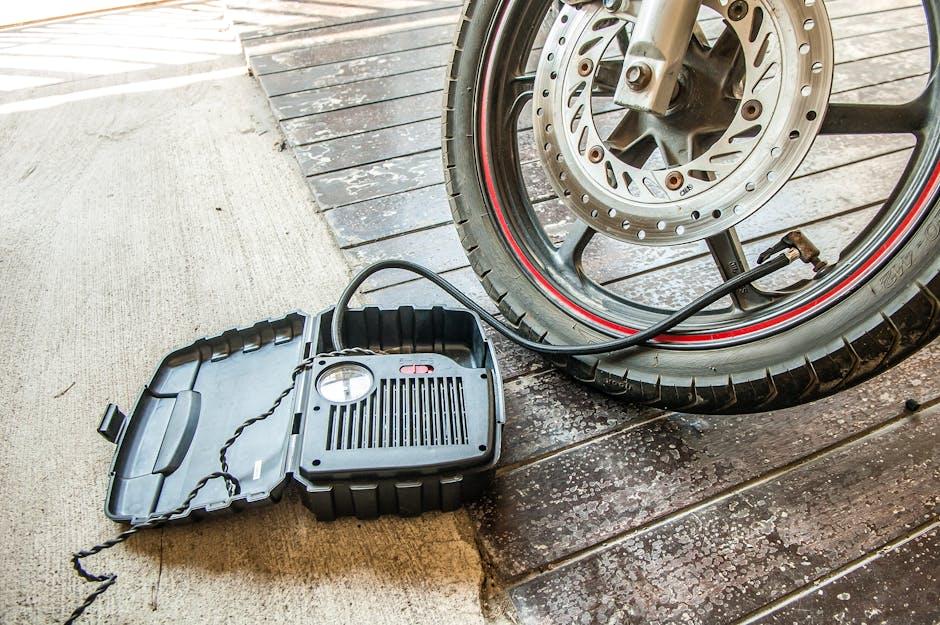As the summer heat bears down and every journey becomes a test of endurance, the comfort of a well-functioning car air conditioning system is nothing short of a modern-day luxury. Yet, like any intricate machine, it requires attention and care to perform at its best. Whether you’re a seasoned driver or a casual commuter, understanding how to maintain your vehicle’s air conditioning system can transform sweltering drives into refreshing escapes. This article will guide you through the essential steps and tips to keep your car’s cooling system running smoothly, ensuring that cool breeze is just a switch away whenever you need it.
Table of Contents
- Understanding the Basics of Your Car’s Air Conditioning System
- Identifying Common Signs of A/C Trouble Early
- Essential Tools and Supplies for A/C Maintenance
- Step-by-Step Guide to Cleaning Your Car’s Air Conditioning Components
- How to Check and Refill Refrigerant Safely
- Tips for Keeping Your A/C System Efficient During Seasonal Changes
- Q&A
- Key Takeaways

Understanding the Basics of Your Car’s Air Conditioning System
Your car’s air conditioning system is much more than just a button on your dashboard. At its core, it’s a sophisticated network of components working together to cool and dehumidify the cabin air, ensuring comfort during your drives. The system primarily consists of the compressor, condenser, evaporator, expansion valve, and refrigerant. When the A/C is activated, the compressor pressurizes the refrigerant, turning it into a hot gas that flows to the condenser where it cools down and transforms into a liquid. This refrigerant then passes through the expansion valve, where it becomes a cold, low-pressure vapor before entering the evaporator. As air blows over the evaporator, it absorbs heat from the cabin, cooling the air before it circulates inside your vehicle.
Understanding the mechanics simplifies troubleshooting and maintenance. Here are some key elements to keep in mind for optimal performance:
- Compressor Health: The heart of the system, it pressurizes the refrigerant and requires proper lubrication and electrical functioning.
- Refrigerant Levels: Insufficient refrigerant leads to weak cooling and can damage components.
- Electrical Components: Sensors, switches, and relays coordinate the system operations and should be checked regularly.
- Filter Condition: Cabin air filters prevent dust and debris from entering, maintaining air quality and system efficiency.
| Component | Function | Common Issue |
|---|---|---|
| Compressor | Pressurizes refrigerant | Seizing or leaks |
| Condenser | Cools hot refrigerant | Clogged fins |
| Evaporator | Absorbs interior heat | Mold buildup |
| Expansion Valve | Regulates refrigerant flow | Blockages |

Identifying Common Signs of A/C Trouble Early
Spotting early warnings that your car’s A/C is on the fritz can save you from a miserable drive and costly repairs down the road. Often, these signs start subtly—like the chill factor taking longer to kick in or the air blowing out warmer than usual. You might also hear unusual noises, such as hissing or rattling, when the system is running. Paying attention to these details is crucial because they often signal issues like refrigerant leaks, clogged filters, or compressor malfunctions.
Keep an eye out for the following telltale signs of A/C trouble:
- Diminished Cooling Performance: Airflow isn’t as strong or cold as before.
- Strange Odors: Musty or sweet smells may indicate mold or refrigerant leaks.
- Unusual Noises: Buzzing, clicking, or grinding sounds coming from the vents or engine bay.
- Excess Moisture: Persistent water puddles under your car after using A/C.
| Symptom | Possible Cause | Recommended Action |
|---|---|---|
| Weak cold air | Low refrigerant | Check and recharge system |
| Unpleasant smell | Mold in vents | Clean or replace cabin filter |
| Rattling noise | Loose compressor parts | Inspect and tighten components |
| Water leakage | Clogged drain tube | Clear drain line |

Essential Tools and Supplies for A/C Maintenance
Keeping your car’s A/C in top shape requires having the right gadgets and supplies on hand. Start with a reliable A/C pressure gauge to monitor refrigerant levels accurately. A good set of manifold gauges is indispensable for diagnosing leaks or pressure irregularities. Don’t forget quality refrigerant recharge kits tailored to your vehicle model, which make refilling quick and mess-free. Besides the hardware, investing in a UV leak detection kit can save you time and avoid costly repairs by spotting tiny leaks before they become major problems.
Maintaining clean airflow is just as crucial, so stock up on replacement cabin air filters and a soft-bristle brush or compressed air canister to clear dust and debris from vents. Keep a set of wrenches and screwdrivers handy for loosening panels or topping off fluid reservoirs. Here’s a quick overview of essentials to keep your toolkit sharp and your ride cool:
| Tool/Supply | Purpose |
|---|---|
| A/C Pressure Gauge | Monitor refrigerant levels |
| Manifold Gauges | Diagnose system pressure |
| Refrigerant Recharge Kit | Refill refrigerant safely |
| UV Leak Detection Kit | Identify leaks early |
| Cabin Air Filters | Maintain clean airflow |
| Soft-Bristle Brush/Compressed Air | Remove dust from vents |
| Wrenches & Screwdrivers | Access and service parts |

Step-by-Step Guide to Cleaning Your Car’s Air Conditioning Components
Start by turning off your car’s engine and disconnecting the battery to ensure safety during the cleaning process. Next, locate the air conditioning vents and use a soft brush or compressed air to gently remove any dust and debris that have accumulated. This initial step helps maintain airflow efficiency and prevents contaminants from entering the system. Don’t overlook the cabin air filter—remove it and either clean or replace it depending on its condition. A neglected filter can restrict airflow and cause unpleasant odors.
For a deeper clean, focus on the evaporator and condenser coils located behind the dashboard and in front of the radiator, respectively. Use a specialized automotive coil cleaner spray, applying it carefully to avoid moisture damage to electronic components. Once sprayed, allow the solution to work for the recommended time, then rinse lightly with water if safe or wipe down with a damp cloth. Finally, inspect hoses and connections for any signs of wear or leaks, and tighten clamps as needed. Regular maintenance like this maximizes your AC’s lifespan and keeps it running smoothly.
- Step 1: Safety first – disconnect battery
- Step 2: Clean air vents and replace cabin air filter
- Step 3: Apply coil cleaner to evaporator and condenser
- Step 4: Inspect hoses and tighten connections
| Component | Cleaning Tool | Frequency |
|---|---|---|
| Air Vents | Soft brush/compressed air | Every 3 months |
| Cabin Air Filter | Replacement or vacuum | Every 12,000 miles |
| Evaporator & Condenser | Coil cleaner spray | Annually |

How to Check and Refill Refrigerant Safely
Before you begin refilling your car’s refrigerant, it’s crucial to check for leaks and ensure the system is functioning properly. Start by identifying the low-pressure service port, usually marked with an “L” on the A/C lines. Use a pressure gauge to read the current refrigerant level; a healthy system typically shows between 25-45 psi when the engine is running and A/C is turned on. If levels are low, this signals the need for a refill, but be cautious—overcharging can cause damage or reduce cooling efficiency. Always wear safety gloves and glasses, and work in a well-ventilated area to avoid accidental exposure to refrigerant gases.
- Turn off your engine before connecting any tools.
- Attach the refill hose securely to the low-pressure port.
- Add refrigerant gradually, pausing to check pressure frequently.
- Stop refilling once the optimal pressure range is reached.
- Inspect system for leaks after refilling to ensure sealed integrity.
| Refrigerant Type | Ideal Pressure (psi) | Safety Tip |
|---|---|---|
| R-134a | 25-45 | Use compatible gauges |
| R-1234yf | 30-50 | Handle with care; flammable |

Tips for Keeping Your A/C System Efficient During Seasonal Changes
As the seasons transition, your vehicle’s air conditioning system faces varying demands that can affect its performance. To keep it running optimally, regularly inspect and replace the cabin air filter—this simple step ensures clean airflow and reduces strain on the system. Additionally, periodically running the A/C, even during cooler months, keeps the refrigerant circulating and prevents seals from drying out, maintaining efficiency and preventing leaks.
Small adjustments can make a big difference. Here’s a quick checklist to keep your system in peak condition:
- Seal cracks and gaps: Check door and window seals to prevent cool air from escaping.
- Park in shade: Minimizes the heat buildup inside the car, easing the burden on your A/C.
- Use recirculation mode: This helps cool the cabin faster by reusing the already cooled air inside.
- Schedule professional check-ups: Technicians can detect issues early before they escalate.
| Season | Recommended Action | Benefit |
|---|---|---|
| Spring | Clean/replace cabin filter | Better airflow & fresher air |
| Summer | Run A/C regularly; park in shade | Prevents refrigerant loss; reduces heat stress |
| Fall | Inspect system for leaks | Maintains system pressure |
| Winter | Run A/C occasionally | Keeps seals lubricated, prevents mold |
Q&A
Q&A: How to Maintain Your Car’s Air Conditioning System
Q1: Why is it important to maintain my car’s air conditioning system?
A: Your car’s air conditioning (AC) system keeps you cool and comfortable during drives, especially in hot weather. Proper maintenance ensures it runs efficiently, prevents costly repairs, and prolongs the lifespan of the system.
Q2: How often should I have my car’s AC system checked?
A: It’s ideal to have a professional inspection at least once a year, preferably before the summer season. Regular checks can catch leaks, worn-out parts, or low refrigerant before they become bigger problems.
Q3: What are some simple steps I can take to maintain my car’s AC myself?
A: Start by running the AC for about 10 minutes once a week, even in winter, to keep the system lubricated. Replace the cabin air filter regularly to maintain airflow and reduce strain on the system. Also, keep the condenser (located in front of the radiator) clean and free of debris.
Q4: How do I know if my car’s AC needs professional repair?
A: Signs that you need a repair include weak airflow, strange odors, unusual noises, or if the AC stops cooling effectively. These symptoms often indicate refrigerant leaks, compressor issues, or clogged components.
Q5: Can I recharge my car’s AC refrigerant myself?
A: While DIY recharge kits are available, it’s best to have a certified technician handle refrigerant refills. Incorrect handling can damage the system or result in improper refrigerant levels, reducing efficiency.
Q6: What role does the refrigerant play in my car’s AC system?
A: The refrigerant absorbs heat from inside the car and releases it outside. Without the correct amount and type of refrigerant, your AC won’t cool properly.
Q7: How do weather conditions affect the AC system maintenance?
A: Hot and humid climates put more strain on your AC system, making regular checks even more crucial. Also, pollen and dust in spring can clog filters quickly, impacting airflow and air quality.
Q8: Is it necessary to maintain the AC system during the winter?
A: Absolutely. Running the AC occasionally in colder months helps keep the compressor seals lubricated and prevents them from drying out and cracking.
Q9: What’s the cost implication of neglecting AC maintenance?
A: Neglect can lead to reduced efficiency, higher fuel consumption, and potential system breakdowns that are costly to repair or replace. Regular maintenance saves money in the long run.
Q10: Any tips to extend the life of my car’s AC system?
A: Use the AC regularly, keep cabin air filters clean, park in shaded areas when possible, and schedule annual professional inspections. Treat your AC like a vital part of your vehicle — because it is!
Key Takeaways
Maintaining your car’s air conditioning system doesn’t have to be a daunting task. With a little care and attention, you can ensure that every drive remains cool, comfortable, and refreshing—no matter how high the mercury rises. Remember, a well-tuned AC not only keeps you cool but also protects your vehicle from costly repairs down the road. So, take these tips to heart, make regular check-ups part of your routine, and enjoy the breeze that accompanies every journey. After all, a cool ride is the best companion on life’s winding roads.

